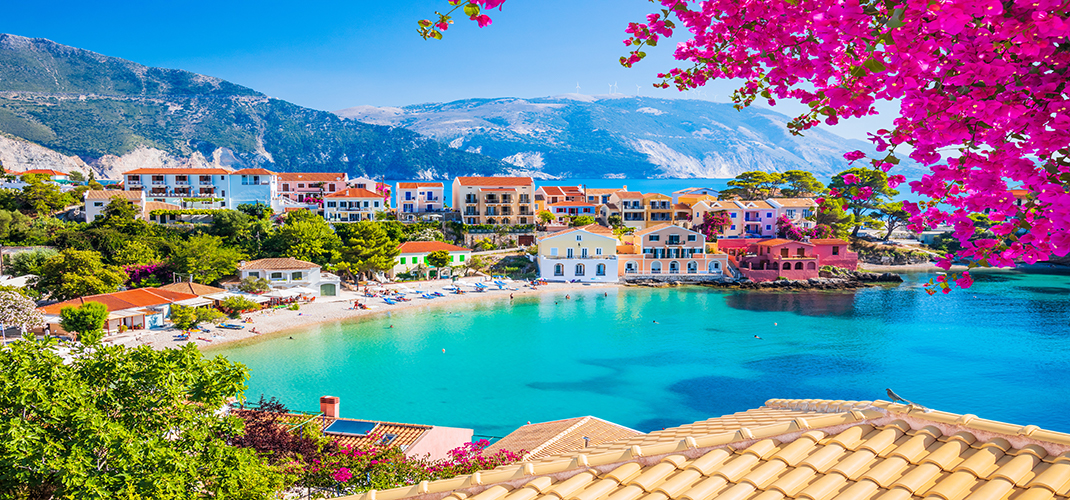Greece

Greece is a country immersed with ancient mythology, archaeology, art and history. Greece is made up of a series of idyllic islands that are surrounded by stunning blue seas and covered in white washed buildings and beautiful coastal towns.
Athens is the Capital of Greece, a busy city with one of the world’s most impressive sights. Dominating the skyline is the Acropolis, a visitor must-see. From the Doric Columns and the spectacular Temples, the Acropolis is lined with paths that let you walk around and enjoy the highlight of this monument, which is the stunning Parthenon. The Acropolis Museum is one of the most popular modern attractions in Athens. Opening in 2009 and made of cutting edge glass and steel, it houses some of the most famous artefacts in Greece. Nearby the Acropolis you will find the Ancient Agora. This area used to be the centre of the city and now houses important buildings, shops and markets. Monastiráki Square is particularly popular with several Churches and Museums. Athens has lots of Museums but the National Archaeological Museum has one of the largest and most comprehensive collections in all of Greece. Other areas to visit include the Plaka with its village feel, narrow cobblestone streets lined with cafés, tavernas and tiny shops selling their wares. Syntagma Square is in the modern part of Athens where you will find the Parliament and the Tomb of the Unknown Soldier. This is guarded by soldiers and every hour there is a changing of the guard.
Mount Olympus is probably one of the most famous mountains in the world. Known in Greek mythology as the spot where Zeus sat on his throne as well as the place where Hades ruled the Underworld.
Delphi is a UNESCO World Heritage Site. Situated on the sides of Mount Parnassus it was a popular pilgrimage spot in the days of old for those who would come here to pay homage to Apollo, the ancient Greek God of healing, music, light, and prophecy. Followers would come here to seek guidance from the Oracle at Delphi however today, you will find Temples, a Theatre and an impressive Stadium amongst the ancient ruins.
Meteora is known for its Monasteries. There are 6 monasteries in Meteora, although at one stage there were 24 Monasteries. As a result, this is one of the most spectacular religious sites in Greece. Meteora is a UNESCO World Heritage Site, a mesmerising group of vertical rocks, reaching up to 300 metres high, which time has twisted into bizarre and beautiful formations. It is one of the most haunting and beautiful landscapes in Europe.
When in Thessaloniki a visit to the Archaeological Museum of Thessaloniki, which is owned by the Ministry of Culture is a must. The building dates back to 1962 and is a modern Greek treasure in itself, a wonderful example of new architecture in Greece. At the Museum you will find artefacts from Macedonia (not the country), an ancient civilisation of Greece, separated into seven sections that you can walk through and, which tells the story of this part of the country.
Situated on the Chalcidice Peninsula is Mount Athos, considered a place of great importance in Greek history. Home to 20 Monasteries that dot its scenic slopes it is a central point of worship in Eastern Christian Orthodox faith. The most amazing detail about the monasteries here is that they are still in full working order and this makes them the oldest monastic community in the world, today.
Mycenae is another UNESCO World Heritage Site and was made famous in Homer’s the Iliad and the Odyssey. Homer claimed that Mycenae was built by Perseus who was the son of Zeus and Danae and it belonged to the Royal House of Atreus. Founded in the 6th Century B.C. the highlights include the mighty Lion Gate and the Royal Cemetery as well as the Agamemnon Palace and the Great Court.
Ancient Corinth is impressive as is situated in a village that emphasizes the difference between modern day surroundings and the ancient ruins, which are a mix of Roman and Greek relics. This used to be the home of Jason of the Argonauts who stole the Golden Fleece. Some of the sights include the Temple of Apollo as well as the Peribolos of Apollo and an Ancient Theatre. Much of the complex is Roman but one Greek addition is the Doric Temple of Apollo that dates back to the 5th Century.
One of the most astonishing feats of engineering in Greece is the Corinth Canal. Taking centuries to build it was started by Nero, the ancient Roman Emperor, before finally being finished under the French in the late 19th Century. The canal is sliced into a section of rock and spans 6 kilometres with sides up to 90 metres.
Epidaurus, in the region of Argolis is the Epidaurus Theater, a ceremonial space that is dedicated to the famous God of medicine, Asclepius. The Sanctuary of Asclepius is located next to the theatre and you can visit both at the same time. Dating back to the 4th Century, you can sit in the stone tiers and imagine watching a performance here in the years of old.
There are 6,000 Greek Islands and Islets scattered across the Greek seas, of which only 227 Islands are inhabited. These islands are a mecca for tourists with their sun kissed scenery, pleasant climate, stunning azure waters, that are dotted with quaint fishing ports and historic villages. For more information on some of the islands, please look under Greek Island Hopping.
